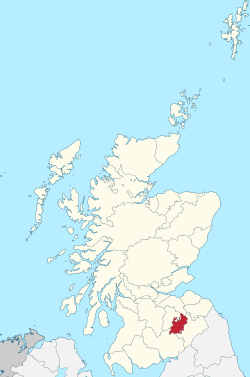Selkirk (county))
| Selkirk | |
|---|---|
| Historic county | |
 |
|
| Country | Scotland |
| County town | Selkirk |
| Area | |
| • Total | 267 sq mi (692 km2) |
| Ranked 27th of 34 | |
| Chapman code | SEL |
Selkirkshire or the County of Selkirk (Scottish Gaelic: Siorrachd Shalcraig) is a registration county of Scotland. It borders Peeblesshire to the west, Midlothian to the north, Berwickshire to the north-east, Roxburghshire to the east, and Dumfriesshire to the south. It derives its name from its county town, the Royal burgh of Selkirk.
Until 1975 it was one of the thirty-three administrative counties of Scotland, with a county council formed by the Local Government (Scotland) Act 1889. Under the Local Government (Scotland) Act 1973 the use of counties as local government areas was abolished across Scotland, with its area becoming part of the Ettrick and Lauderdale district of the Borders Region. Unlike many counties, Selkirkshire has not continued to exist as a lieutenancy area, but has become part of Roxburgh, Ettrick and Lauderdale for these purposes.
In the 1st Century AD Selkirk formed part of the lands of the native people who hunted it rather than settled there. Neither the Romans, Angles, or the Saxons cleared much of the forestry there and for centuries Selkirk was known for its forest coverage. Indeed, an alternative name for the county was Ettrick Forest. Under the Scottish kings the forest was regarded as Royal. Despite this it was not until the reign of James V that sheriffs were appointed to administer the county on the Crown's behalf. During the military occupation of Scotland by Edward I of England, the forest was granted to the Earl of Gloucester.
...
Wikipedia
